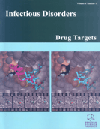-
oa RNA Interference-Based Therapeutics: New Strategies to Fight Infectious Disease
- Source: Infectious Disorders - Drug Targets (Formerly Current Drug Targets - Infectious Disorders), Volume 8, Issue 4, Dec 2008, p. 262 - 273
-
- 01 Dec 2008
- Previous Article
- Table of Contents
- Next Article
Abstract
For many years, there has been an ongoing search for new compounds that can selectively alter gene expression as a new way to treat human disease by addressing targets that are otherwise “undruggable” with traditional pharmaceutical approaches involving small molecules or proteins. RNA interference (RNAi) strategies have raised a lot of attention and several compounds are currently being tested in clinical trials. Viruses are the obvious target for RNAitherapy, as most are difficult to treat with conventional drugs, they become rapidly resistant to drug treatment and their genes differ substantially from human genes, minimizing side effects. Antisense strategy offers very high target specificity, i.e., any viral sequence could potentially be targeted using the complementary oligonucleotide sequence. Consequently, new antisense-based therapeutics have the potential to lead a revolution in the anti-infective drug development field. Additionally, the relatively short turnaround for efficacy testing of potential RNAi molecules and that any pathogen is theoretically amenable to rapid targeting, make them invaluable tools for treating a wide range of diseases. This review will focus on some of the current efforts to treat infectious disease with RNAi-based therapies and some of the obstacles that have appeared on the road to successful clinical intervention.


